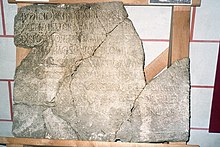Salomon Tower Museum
The Salomon Tower Museum is located in the Salomon Tower (Hungarian Salamon-torony ), the core of a medieval defensive bastion in the city of Visegrád in Pest County, Hungary . The branch belonging to the Visegráder Mátyás Király Múzeum (King Matthias Museum) houses archaeological and historical objects relating to local history.
History of the tower
The mighty, rectangular residential tower , which forms the center of the Lower Castle on the eastern edge of the Visegrad defense system, was named after the Hungarian King Solomon (1053-1087), who was allegedly imprisoned there. Since the lower castle was only built between 1250 and 1260, scientists instead suspect that the late Roman fort Visegrád-Sibrik above the tower was the actual involuntary residence of Solomon. The ancient walls of the fortifications and a large burgus existed until the Middle Ages .
During the Turkish Wars , the Lower Castle was destroyed and the tower was badly damaged. From 1871 onwards, citizens of Visegrad began to restore the castle complex as part of a nationwide romanticism for early Hungarian history. During the interwar years, the first archaeological collection was set up in the renewed defense tower. In 1950 a fire destroyed large parts of the reconstruction. Between 1959 and 1964 the architect János Sedlmayr rebuilt the tower very freely in a clearly visible reinforced concrete construction , which deliberately wanted to differentiate between the originally preserved walls and the modern ingredients.
museum
The tower museum offers exhibition space on three levels. The ground floor is dedicated to a huge high-Gothic fountain, reconstructed from original parts , which once adorned the courtyard of the royal palace of Visegrád under King Sigismund of Luxembourg (1368–1437). In the course of the Renaissance renovation of the palace under King Matthias Corvinus (1443–1490), this fountain was removed again and replaced by a contemporary work.
On the first floor, sculptures, components and religious objects from the Middle Ages and the Renaissance are presented, which came to light during the excavations in the Visegrad Castle, including the Visegrad Madonna, which is now on display in the partly reconstructed church ruins of the castle.
The second floor contains objects from prehistoric times to the 20th century that are important for local history and the Danube Bend . The excavation results from the Visegrád – Gizellamajor fort and the findings from the Burgi Visegrád quarry (Burgus Solva 24) and Visegrád-Lepence (Burgus Solva 35) are of supraregional rank . The Burgus Solva 35 is shown in more detail with a partial reconstruction of the entrance area. The building inscriptions of both Burgi, which are so important for dating, can also be seen. Finds from the nearby Visegrád – Sibrik castle can also be viewed.
Web links
- The Solomon Tower on the official website of visegradmuzeum.hu (in Hungarian)
- The Tower of Solomon and its history on the official website of visegrad.hu (in Hungarian)
Individual evidence
- ^ Christian Lübke : Eastern Europe. Siedler Verlag, Munich 2004, ISBN 3-88680-760-6 . P. 258.
- ^ Walter Frodl: Contributions to art history and preservation of monuments. W. Braumüller Verlag, Vienna 1975. p. 115.
- ↑ Query on January 25, 2014 at www.ubi-erat-lupa.org .
- ↑ AE 2000, 1223 .
Coordinates: 47 ° 47 ′ 46.8 " N , 18 ° 58 ′ 38.2" E


